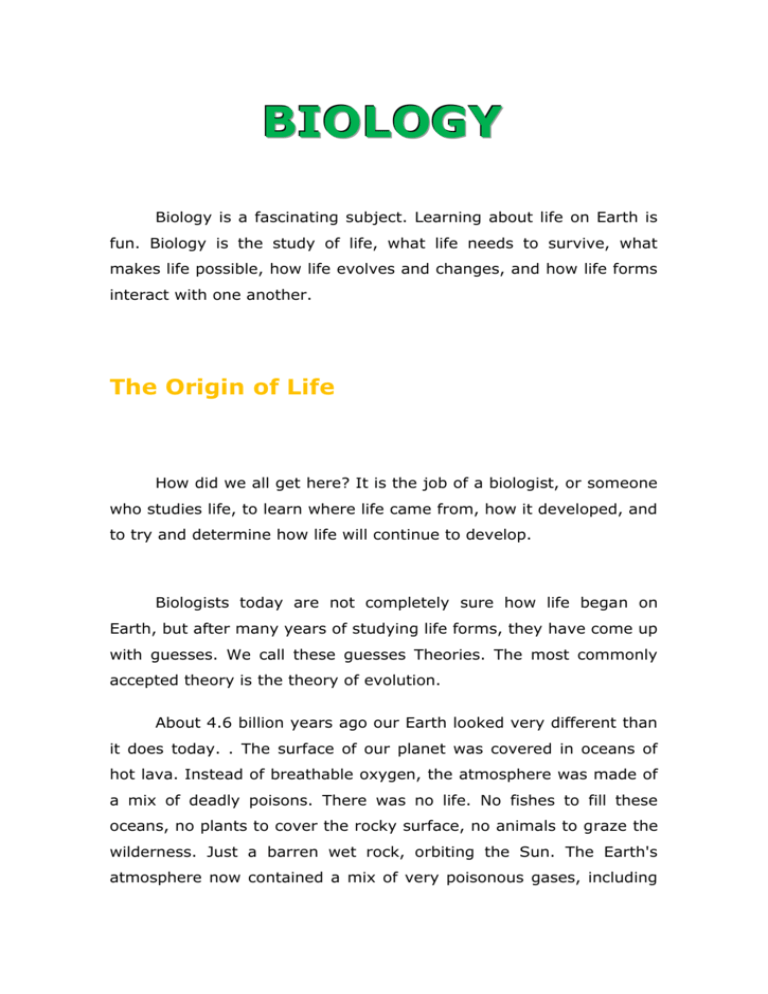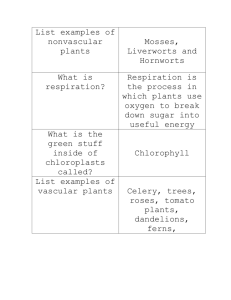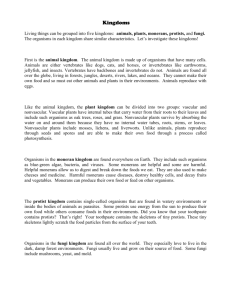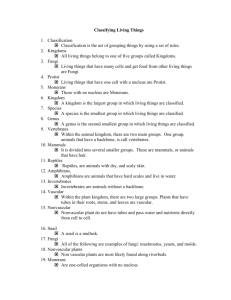BIOLOGY Biology is a fascinating subject. Learning about life on
advertisement

BIOLOGY Biology is a fascinating subject. Learning about life on Earth is fun. Biology is the study of life, what life needs to survive, what makes life possible, how life evolves and changes, and how life forms interact with one another. The Origin of Life How did we all get here? It is the job of a biologist, or someone who studies life, to learn where life came from, how it developed, and to try and determine how life will continue to develop. Biologists today are not completely sure how life began on Earth, but after many years of studying life forms, they have come up with guesses. We call these guesses Theories. The most commonly accepted theory is the theory of evolution. About 4.6 billion years ago our Earth looked very different than it does today. . The surface of our planet was covered in oceans of hot lava. Instead of breathable oxygen, the atmosphere was made of a mix of deadly poisons. There was no life. No fishes to fill these oceans, no plants to cover the rocky surface, no animals to graze the wilderness. Just a barren wet rock, orbiting the Sun. The Earth's atmosphere now contained a mix of very poisonous gases, including carbon monoxide, carbon dioxide, nitrogen, hydrogen sulfide, methane, and cyanide. Breathing this air would cause death to most life forms as we know them. So how did life arrive on Earth? What came first? The chicken, or the egg? This riddle seems silly, but think about it. Without chickens, there could be no one to lay eggs. Yet, without eggs, there could be no chickens, because they could not have hatched. So which came first? A complicated question, and not just about chickens, but about all life forms. What forces changed this barren waist land into the beautiful garden that it is today? Biologists believe that the process that created life is something called evolution. Earth's ancient oceans, while lifeless, but were filled with the chemicals needed for life. These chemicals were not alive, but they were there, sloshing around. They call these chemicals “Primordial soup”. This soup was filled with amino acids, proteins, lipids, and other basic components that are commonly found in life forms today. It is believed that life began on the shores of these ancient oceans, in pools of water called tidal pools. These shallow pools would have been full of this “life soup”. Over many millions of years, as the ingredients of life splashed around in these pools, possibly helped by lightning strikes, they formed the first cells. What is a cell? A cell is a basic unit of life. They are tiny packets, or bags of organelles or tools needed for the cell to survive. A cell can eat, move around, and reproduce. these cells took the chemicals of life, found in the soup, and put them together inside protective sacks. These first cells were very simple, and because there was little or no oxygen available probably did not need it to survive. What did these first cells eat? As strange as it may seam, the first cellular life forms on earth probably ate soup. Not Chicken Noodle Soup, but the same soup that they formed in. At that time, there were plenty of proteins, amino acids, and lipids to go around. The first cells were probably all consumers. The ancestors of animals. Over millions of years time, had to form. These cells were called producers. Producers evolved the ability to actually create their own food, using the chemicals around them, and the energy from the Sun, or from heat found in the Earth. These producers would be ancestors to the plants From very simple cells, to multi-cellular human beings, life had a long way to go. A number of very important advances in evolution allowed life to become what it is today. The first important advancement was the development of cells that use oxygen. Remember, the first cells could not use oxygen, because there was not enough of it in the air. However, as these first cells carried out the business of living, they released oxygen into the atmosphere. Over a very long period of time, our atmosphere changed from a poisonous and deadly mix of gases, to the atmosphere we know today . As the atmosphere changed, so did life. Cells evolved that could use oxygen to carry out their bodily functions. Because oxygen is a much more efficient gas, this opened the door to larger, faster, and more complex cellular life forms. The next major evolutionary advance, was the development of multi-cellular life forms. No longer was life limited to just one cell. Creatures began to arise that were made up of two cells, ten cells, or even thousands, or billions of cells. These cells began to specialize in different jobs. Some acting as hearts, others as eyes, others as brains, allowing life to become very complex. Over millions of years, plants and animals have evolved into many different forms. Some with big mouths, some with small mouths, some with sharp teeth, some with no teeth, eyes in the front, eyes on the side, two eyes, eight eyes, and everything in between. All of this evolution guided by the simple law of survival of the fittest. Lets consider another example. Instead of hippopotamuses, this time we will examine birds. Birds have a very big advantage over other life forms. They can fly. This ability allows them to move around quickly, as well as the ability to easily escape from predators. What is Life? Look around you. What do you see? A classmate, a brother or sister? Look out the window, or go for a walk. You will see trees, grass, plants, dogs, cats, bugs, and many other forms of life. Now, think about this. Life extends much further than what you can see. Everywhere around you, all over your keyboard, the computer monitor, your desk, the walls, the floor, the ceiling, your clothes, and even your skin, you can find billions and billions of tiny microscopic life forms. Life is all around us. From many kilometers (miles) into the atmosphere, to many meters (feet) beneath the surface of the Earth, life is everywhere. What is this stuff we call life? What are some things that all life forms have in common? Living Things Are Made of Cells All living things are made up of cells. These cells are the basic building blocks of life. As an example, have you ever seen a sand castle? At a distance, the sand castle looks like a smooth brown building. As you get closer to the sand castle, you can begin to see that it is not one smooth building, but instead that it is made up of millions of tiny grains of sand. Looking at an elephant, you might see what looks like a smooth gray animal. And it is true that this is what you are seeing. However, just like the sand castle, if you could get close enough, and if your eyes were powerful enough, you would realize that what looks like a smooth gray surface, is really made up of many billions of smaller objects called cells. Cells are tiny units of living materials separated by a cellular wall, or barrier. These cells are so small, that they can only be seen with a powerful tool known as a microscope. Cells make up every part of a living thing. Your skin, your hair, fingernails, blood, bones, nerves, and muscles are all made up of cells. These cells work together to keep the life form alive. Many life forms can move. Just like you, they might move to find food, to find shelter, to avoid danger, or in response to their environment. Animals move in many different ways. They might use fins to push them through the water, wings to help them fly, feet, tails, hands, Plants also move. They of course can not move as well as animals, but many plants move their stems to face the Sun, open and close flowers, and more. Some carnivorous plants even move to trap prey. Living Things Perform Chemical Reactions Inside complex taking take living chemical place. place organisms as things, reactions Chemical outside well, very are reactions of but living not on anywhere near the same level. A living organism is a mini-chemistry lab. These chemical reactions are carrying out the functions necessary for life, including breaking down food so that it can be used for energy, creating food, building new cells, repairing body parts and more. Living Things Respond To The Environment Around Them One of the most important characteristics of living things, is that they respond to the environment around them. This one single characteristic makes them very different from non-living things, which do not respond to the environment, but instead just let what ever happens to them happen. Your own body responds to its environment in order to keep you healthy. You might sneeze, to keep dust and germs from entering through your nose, your immune system responds to invaders by producing anti-bodies, etc. Living Things Reproduce A very important part of the life of living things is the ability and opportunity to reproduce, to create offspring. Reproduction is the process of one or more living things creating another living thing. Your parents created you. A mother and father dog reproduce, creating puppies. By reproducing, living things are able to pass on their characteristics to another generation. Living Things Die Something that is definitely unique to living things is that they die. Anything that is alive will eventually die. The period of time that something is expected to live is called the living thing‘s “life span”. The life span of living things can vary significantly. Some things have a life span of only a few hours, or a couple of days. Some bacteria, and insects, for example, begin their lives, mature, reproduce, and then die, all within a couple hours. Other living things can live for many years, such as an elephant, who might live for 70 years, and a human, which can live for 100 years. Then there are the living things which seem to live forever. A bristle cone pine tree they can live 5,500 years. That means that today there are bristle cone pine trees alive, that began their lives before ancient Rome, and even before many of the ancient Egyptian pharos. Even these long lived organisms will all eventually die. Needs of Living Things What do you need to live comfortably? The list probably includes food, a home, clothes, and water. Other needs might include love, an education, friends, enough space to play, and many other things. If you have pets, what do they need to live a comfortable life style? Probably many of the same things, food, water, exercise, and more. Living things have many different needs. Fish need water to survive, your pet hamster needs a clean cage, and plants need sunlight to make food. All around us, living things are using their environment to fill these needs. Living things often use other living things to satisfy needs, such as in the example of a lion, who uses his prey as food, or the bacteria in your body, which uses you as shelter. Other times, living things use non-living things to fulfill their needs. This might be the lizard who uses a crack in a cliff side to hide, or plants who use minerals from the soil to create food. All life forms have different needs. For example, most fish do not fly, and most birds do not swim, while most plants don't do either. However, all life forms do have a few of the same basic needs in common. Almost all living things need energy, food, water, oxygen, space, and the ability to maintain homeostasis. All life forms need energy to survive. Energy is the resource that allows organisms to do things. What kinds of things might an organism do with energy? This answer to this question is as varied as the life forms that use energy. Some, like the African Lion, use energy to chase after prey. Other life forms, like many creatures we find in the depths of the Earth's oceans use energy to create their own light. Living things use energy to grow, to defend themselves, and to move around. Energy With so many living things around us using energy every day, you might ask where all this energy comes from. The main source of energy on the Earth today is the Sun. The energy found in your body, that you use to run, jump, and play sports, was originally produced by the Sun. Plants use sunlight to create their own food. Many animals then eat the plants, taking this energy into their own bodies. Other animals then eat these plant eaters, passing the Sun's energy from one organism to another. Food All living things need a source of food. The food organisms take in provides them with energy, and also provides them with the resources, and raw materials they need to build up their bodies, grow, and repair damage. The foods that living things consume are very different depending on the life form. A cow eats a very different diet then a tiger. Even among humans, there is a lot of difference in what people eat around the world. Plants use sunlight to create their own food. Water How long can you go without water. After only a few hours, you will begin to get thirsty. Within a couple days you without water, you would get very sick. Without water, your body would die within about a week, possibly even sooner. Living things need water to survive. But why is water so important? All life forms on Earth are comprised almost entirely of water. Your own body is about 66% water. Water in your blood helps transport food, and chemicals to your cells. It helps remove waste products from your body. Water is used to cool you down, to warm you up, and to carry out the chemical reactions that allow you to move and grow. Another important use of water, is to keep your body clean. Plants use water to grow, to transport food, and to carry out chemical reactions. In addition, plants use water as part of photosynthesis, to create their own food. Oxygen Without food, your body would die in a matter of weeks. Without water, you would day in days. How long do you think you would live without oxygen? As an experiment, see how long you can hold your breath. How quickly does your body let you know it needs more air? Most life forms use oxygen as the main ingredient in many of the chemical reactions needed for life. This is because oxygen is a very efficient element. The availability of oxygen in the Earth's atmosphere is believed by biologists to be a major reason for the advancement of life on Earth. Without it, life would probably still be very small, and very slow. Organisms get oxygen from their environment in a variety of ways. Many land animals breath oxygen directly from the air, while ocean bearing animals often use the oxygen dissolved in the water to survive. No matter how they get it, oxygen is an important need for almost all life forms. Homeostasis Homeostasis is a big word that biologists use to indicate that an organism needs to keep conditions inside of itself the same, even though conditions outside are always changing. One very important part of homeostasis is body temperature. On any particular day, the temperature might change by as much as 50º. In order for an organism's chemical reactions to continue as they should, the temperature on the inside of the organism needs to remain the same. How do living things maintain homeostasis? When your body temperature begins to rise, what happens? You begin to sweat. Sweating is your bodies way of cooling down, and thus maintaining homeostasis. What do dogs do to cool down? Living things have many unique tricks that help them maintain the same conditions inside themselves. The 5 Kingdoms. Classification. Biologist today have classified and divided all living things into five groups they call Kingdoms. These kingdoms are based on how living things are the same, and how they are different. It is important that you understand, that biologist are still learning about our world, and are making new discoveries every single day. As our knowledge about the world around us improves, scientists might find a better way to organize and classify life. As a result, these five kingdoms may someday change. The five kingdoms currently accepted by most (but not all) scientists are The Moneran Kingdom, The Protist Kingdom, The Fungi Kingdom, The Plant Kingdom, and The Animal Kingdom. Moneran The Moneran Kingdom consists of unicellular life forms. Unicellular means that they only have one cell. Moneran cells are far simpler and more basic than the cells of other life forms. These cells have no nucleus, and are also missing many of the organelles, or parts, commonly found in other cells. For this reason, Monerans are thought to be very distantly related to other life forms. Monerans are classified into two phyla, or groups, autotrophs, and heterotrophs. Autotrophs are able to create their own food, similar to plants. Heterotrophs can not create their own food, and so must rely on autotrophs as their food source. Bacteria are commonly placed in The Moneran Kingdom. Monerans are considered by many scientists to be the oldest life forms on Earth, and the ancestors of all the other types of life that have since evolved. Protists The Protista Kingdom consists of unicellular life forms (life forms with only one cell) who have a nucleus. The primary difference between protists and monerans is that protists are more complex, having a nucleus. Fungi The Fungi Kingdom is made up of a variety of different funguses. For many years, it was believed that fungi were plants. Today we know that fungi are different from plants in some very important ways. Firstly, unlike plants, fungi cannot make their own food. They must rely on other food sources to support them. There are also differences in the basic make up and chemistry of their cells. One common type of fungi are the mushrooms you find on your pizza. Other fungi include microscopic fungus, truffles, and more. Plants The Plantae Kingdom is made up of all the plants that you see each day. Most plants are multicellular, meaning that they consist of many cells. Different types of plants include trees, grass, Plants use the light from the Sun to produce their own food. This allows them to grow almost anywhere, as long as there is enough water. Plants get their green color from the chlorophyll which is found inside of their cells. Plants use chlorophyll to collect energy from the light of the Sun. They then use this energy to create food. In this process, they create the food we eat, and the oxygen we need to breath. Plants are very important to the life of almost every other living thing. Animals Like many other life forms, animals are multi-cellular. These cells come together, forming tissues, organs, and organ systems, that help sustain the life of the animal. From elephants to snails, animals come in many shapes and sizes, and can be found all over the world. Animals cannot make their own food. They must rely on other living things, such as plants, fungi, and other animals to sustain them. Without other food sources, animals could not survive. There are more species of animals, then in all the other kingdoms combined. From worms, to blue whales, to bald eagles, animals have evolved to fit a wide variety of niches. Biology Quiz Enjoy our fun biology quiz. Answer questions about evolution, cells, microbiology and more. Find out just how much you've been paying attention during biology lessons at school. 1. Which famous scientist introduced the idea of natural selection? 2. A person who studies biology is known as a? 3. Botany is the study of? 4. Can frogs live in salt water? 5. True or false? The common cold is caused by a virus. 6. Animals which eat both plants and other animals are known as what? 7. Bacterial infections in humans can be treated with what? 8. A single piece of coiled DNA is known as a? 9. A group of dog offspring is known as a? 10. The area of biology devoted to the study of fungi is known as? 11. What is the name of the process used by plants to convert sunlight into food? 12. The death of every member of a particular species is known as what? 13. The process of pasteurization is named after which famous French microbiologist? 14. True or false? A salamander is a warm blooded animal? 15. A change of the DNA in an organism that results in a new trait is known as a? Biology Quiz Answers 1. Charles Darwin 2. Biologist 3. Plants 4. No 5. True 6. Omnivores 7. Antibiotics 8. Chromosome 9. Litter 10. Mycology 11. Photosynthesis 12. Extinction 13. Louis Pasteur 14. False 15. Mutation








